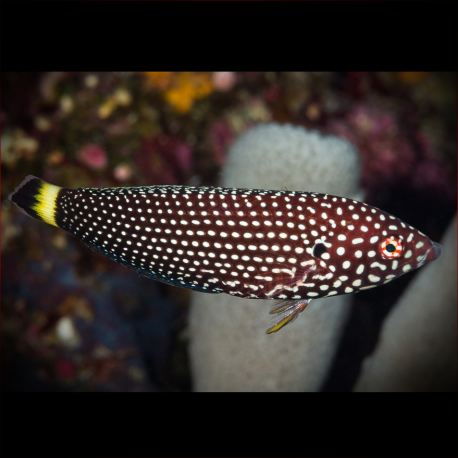More info
Datasheet
| Minimum Tank Size | 400 litres / 105.67 US gallons |
| Maximum Size | 12.0cm / 4.72inches |
| Reef Compatible | Always reef safe |
| Temperament | Docile but might be aggressive towards similar species of same gender |
| Temperature | 22.2°C / 71.96°F - 25.6°C / 78.08°F |
| Specific Gravity | 1.020-1.025 |
| Carbonate Hardness | 8-12 |
| pH | 8.1-8.4 |
General Description
The White-spotted wrasse, scientifically known as Anampses melanurus, belongs to the Labridae family. Known for their striking appearance, these fish display significant differences in coloration between sexes, age groups, and individuals. The species is native to the Pacific Ocean, ranging from Indonesia to the Marquesas and Society Islands, extending north to the Ryukyu Islands and south to Scott Reef, with a distribution that includes Easter Island.
Aquarium Suitability
The White-spotted wrasse is best suited for experienced hobbyists who can provide the necessary preparation and care due to its demanding nature. Sensitive during transportation and acclimatization, these fish require frequent feeding, particularly live food, to thrive in captivity. They are docile but can show aggression towards similar species of the same gender, making careful consideration essential when selecting tank mates.
Demands, Care, and Hardiness
Requiring an average level of hardiness, these wrasses prefer a minimum tank size of 400 liters and a deep sandy substrate of at least 5 cm to burrow when scared or resting. They acclimatize best when introduced as juveniles, and multiple color variations in the species can pose challenges in identification. Feeding twice a day when fully grown is recommended, with a diet consisting of small crustaceans, zooplankton, and other invertebrates.
Reef Suitability
Considered reef-safe, the White-spotted wrasse is generally peaceful towards other tank inhabitants and poses minimal threat to shrimps or invertebrates. They do well in a reef environment and can help control unwanted invertebrate populations, such as flatworms and pyramid snails.
Aquarium Setup
Setting up an aquarium for White-spotted wrasses requires a well-established tank with peaceful species or an empty tank initially, as these fish can be shy and may take time to adjust. Maintaining water conditions with a pH of 8.1-8.4, a specific gravity of 1.020-1.025, and temperatures between 22.2-25.6°C is crucial for their well-being.
Behaviour
Known for their docile temperament, these wrasses tend to bury themselves in the sand when threatened or in need of rest. They thrive best in small groups with just one male present, displaying burying as a defense mechanism. Those feeling threatened may become reclusive until they feel safe to emerge.
Feeding and Diet
The White-spotted wrasse requires frequent feeding, especially when first introduced to an aquarium. Offering live food is beneficial for their adjustment and overall health. Their diet should include a variety of small crustaceans, zooplankton, and other invertebrates to meet their nutritional needs adequately.
Dimorphism and Captive Reproduction
This species exhibits dimorphism, with differences in appearance between males and females. Additionally, they are hermaphroditic, capable of changing gender from female to male based on the social dynamics within their group. Successful captive reproduction of these wrasses can be challenging due to their specific dietary and environmental requirements.
Habitat and Distribution
White-spotted wrasses are commonly found in the East Indian Ocean, Australia, Japan, Indonesia, and various regions of the Pacific Ocean. They inhabit coral reef environments, where they play a vital role in maintaining the ecosystem by controlling populations of certain invertebrates. Their distribution includes a wide range, from Indonesia to the Marquesas and Society Islands, with additional sightings near the Ryukyu Islands and Scott Reef, extending to Easter Island.

